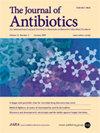Differential gene expression analysis shows that cephalosporin resistance is intrinsic to Clostridioides difficile strain 630
IF 2.1
4区 医学
Q3 BIOTECHNOLOGY & APPLIED MICROBIOLOGY
引用次数: 0
Abstract
Clostridioides difficile infection (CDI) is the most common nosocomial infection in the US. CDI has become a growing concern due to C. difficile’s resistance to several antibiotics, including cephalosporins. Furthermore, patients administered cephalosporins are at higher risk of contracting CDI. Cephalosporins are β-lactam antibiotics, which prevent bacterial cell wall synthesis by inhibiting penicillin-binding proteins (PBPs). β-lactam-resistant bacteria evade these antibiotics by producing β-lactamases or by harboring low-affinity PBPs. A genomic analysis of C. difficile strain 630 identified 31 putative β-lactam resistance genes. Upon cefoxitin exposure, few C. difficile strain 630 putative antibiotic-resistant genes were overexpressed. Most notably, the β-lactamase blaCDD gene was upregulated approximately 600-fold, as previously reported. Deletion of the blaCDD locus did not change in cephalosporin susceptibility. Deletion of the second most upregulated gene, the PBP vanY, was also ineffective at decreasing cephalosporin resistance. Cefoxitin exposure of the C. difficile strain 630ΔblaCDD mutant did not increase upregulation of other putative antibiotic resistance genes compared to wildtype C. difficile strain 630. Transcriptomic analyses of wildtype C. difficile strain 630 exposed to cephradine, cefoxitin, ceftazidime, or cefepime revealed the shared upregulation of a putative heterodimeric ABC transporter encoded by loci CD630_04590 (ABC transporter ATP-binding protein) and CD630_04600 (ABC transporter permease). These genes are genomically located directly downstream of blaCDD (CD630_04580). The deletion mutant CD630_04600 remained resistant to a number of antibiotics. Thus, even though blaCDD, CD630_04590, and CD630_04600 are all upregulated when exposed to cephalosporins, they do not seem to be involved in antibiotic resistance in C. difficile strain 630.

差异基因表达分析表明,艰难梭菌菌株630对头孢菌素具有内在抗性。
艰难梭菌感染(CDI)是美国最常见的院内感染。由于艰难梭菌对包括头孢菌素在内的多种抗生素产生耐药性,艰难梭菌感染日益受到关注。此外,使用头孢菌素类药物的患者感染 CDI 的风险更高。头孢菌素是β-内酰胺类抗生素,它通过抑制青霉素结合蛋白(PBPs)来阻止细菌细胞壁的合成。耐β-内酰胺细菌通过产生β-内酰胺酶或携带低亲和力的PBPs来逃避这些抗生素。对艰难梭菌 630 株的基因组分析发现了 31 个推测的β-内酰胺耐药基因。暴露于头孢西丁后,艰难梭菌 630 株的少数推定抗生素耐药基因被过度表达。最值得注意的是,β-内酰胺酶 blaCDD 基因上调了约 600 倍,这与之前的报道一致。删除 blaCDD 基因座不会改变对头孢菌素的敏感性。删除第二大上调基因 PBP vanY 也不能有效降低头孢菌素耐药性。与野生型艰难梭菌菌株 630 相比,艰难梭菌菌株 630ΔblaCDD 突变体暴露于头孢西丁后,其他推定抗生素耐药基因的上调并没有增加。对暴露于头孢拉定、头孢西丁、头孢唑肟或头孢吡肟的野生型艰难梭菌 630 株进行转录组分析,发现由 CD630_04590(ABC 转运体 ATP 结合蛋白)和 CD630_04600(ABC 转运体渗透酶)基因座编码的推测异源 ABC 转运体共同上调。这些基因在基因组上位于 blaCDD(CD630_04580)的直接下游。缺失突变体 CD630_04600 仍对多种抗生素具有抗药性。因此,尽管 blaCDD、CD630_04590 和 CD630_04600 在暴露于头孢菌素时都会上调,但它们似乎与艰难梭菌 630 株的抗生素耐药性无关。
本文章由计算机程序翻译,如有差异,请以英文原文为准。
求助全文
约1分钟内获得全文
求助全文
来源期刊

Journal of Antibiotics
医学-免疫学
CiteScore
6.60
自引率
3.00%
发文量
87
审稿时长
1 months
期刊介绍:
The Journal of Antibiotics seeks to promote research on antibiotics and related types of biologically active substances and publishes Articles, Review Articles, Brief Communication, Correspondence and other specially commissioned reports. The Journal of Antibiotics accepts papers on biochemical, chemical, microbiological and pharmacological studies. However, studies regarding human therapy do not fall under the journal’s scope. Contributions regarding recently discovered antibiotics and biologically active microbial products are particularly encouraged. Topics of particular interest within the journal''s scope include, but are not limited to, those listed below:
Discovery of new antibiotics and related types of biologically active substances
Production, isolation, characterization, structural elucidation, chemical synthesis and derivatization, biological activities, mechanisms of action, and structure-activity relationships of antibiotics and related types of biologically active substances
Biosynthesis, bioconversion, taxonomy and genetic studies on producing microorganisms, as well as improvement of production of antibiotics and related types of biologically active substances
Novel physical, chemical, biochemical, microbiological or pharmacological methods for detection, assay, determination, structural elucidation and evaluation of antibiotics and related types of biologically active substances
Newly found properties, mechanisms of action and resistance-development of antibiotics and related types of biologically active substances.
 求助内容:
求助内容: 应助结果提醒方式:
应助结果提醒方式:


